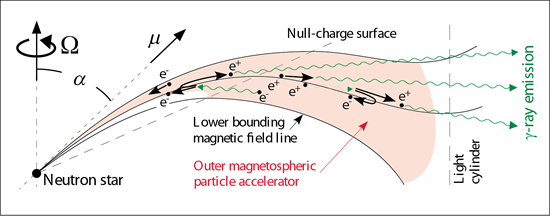研究成果藝廊
Schematic picture (side view) of a pulsar magnetosphere.
圖片來源: Kouichi Hirotani

Schematic picture (side view) of a pulsar magnetosphere. The filled circle on the left denotes the neutron star, which rotates along the vertical axis (dash-dotted line) with angular frequency "Omega". The magnetic dipole axis (short dashed line) is inclined to the rotation axis with angle "alpha". The neutron star has the magnetic dipole moment with strength. As the neutron star spins down, its rotational energy is dissipated in the form of the Poynting flux (i.e., outward flow of electro-magnetic energy), rest-mass and kinetic energies of the electrons and positrons, and the gamma-ray energies. The solid curves designate the magnetic field lines. In the convex side of the lower bounding magnetic field line, a high vacuum is maintained, because charged particles efficiently escape across the light cylinder (vertical long dashed line on the right). As a result, an electric field arises along the local magnetic field lines in the red, shaded region. In this ‘outer-magnetospheric particle accelerator’, electrons (e-) and positrons (e+) are created by photon-photon collisions and accelerated by the magnetic-field-aligned electric field in the opposite directions along the magnetic field lines. Gamma-rays are emitted mostly outwards by the out-going particles (e+). The gamma-ray luminosity is essentially determined by the trans-magnetic-field thickness of the accelerator, which is, in turn, controlled by the efficiency of the photon-photon collisions that take place within the accelerator.